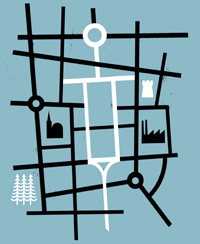By John Thornton | 1 May 2012
With major demographic and other pressures on the NHS, the focus for health services is shifting from acute hospital care to prevention in the community
 Last week, I had an NHS health check-up at my local supermarket. I popped in for some bread, milk and a newspaper and came out with a health assessment and advice on reducing the risk of a heart attack.
Last week, I had an NHS health check-up at my local supermarket. I popped in for some bread, milk and a newspaper and came out with a health assessment and advice on reducing the risk of a heart attack.
The ten-minute once-over took place in one of two makeshift cubicles constructed of packs of kitchen rolls. A very friendly nurse weighed me, measured my height, took my blood pressure, checked glucose and cholesterol levels and completed a lifestyle assessment. The results were all captured on laptop and given to me as a printed report, plus copied to my GP.
This is just one of the ways in which health care is being taken out into the community and the emphasis is moving away from reactive treatment to prevention. The nurse explained that during the course of the week they had seen hundreds of people, many of whom had not been to their GP for some time and would not normally have a check-up. They had also identified several people at high risk of heart attacks, strokes and diabetes who they had advised to visit their GPs. If this initiative is successful, it should help to improve the overall health of the local population as well as reduce the pressures on the NHS that result from emergencies and long-term after-care.
The combination of an ageing population and pressures on NHS budgets means that everybody will need to take greater responsibility for their health.
To achieve this, individuals will need to be better informed about the state of their health, the risks they face, lifestyle choices about diet and preventative strategies. This will require much better information to be available and shared with the wider population as well as easier access to advice to help guide us through the maze of often conflicting, changing and sometimes partial advice.
It also means looking at ways in which changes in attitudes and community-wide action can affect the overall health of the local population. In Scotland, for example, there has been a 10% drop in the premature birth rate since it introduced a ban on smoking in public places, in addition to reductions in heart disease and childhood asthma. This reduction in premature births was in both non-smokers and women who smoked when pregnant, which researchers say suggests a link to exposure to passive smoking.
Dementia affects one in 14 people over the age of 65 and one in six over the age of 80. It is estimated that there could be 1 million sufferers by 2020, at a cost of £20bn a year. But, for many, help comes only when the disease is really advanced. A pilot project in Bournemouth is attempting to help speed up identification of the disease by training staff in local banks and shops to spot the early signs in customers and then alert local health staff. The aim is that the NHS and local government can then work together to help people in the early stages through a combination of one-on-one support and a range of group activities.
The latest estimates are that NHS spending alone will account for almost 30% of all public spending by 2014/15, up from 20% at the start of the 1990s. By 2017, we will need another round of expenditure cuts of the same magnitude to accommodate our ageing population and to bring overall public spending below 40% of gross domestic product.
I wonder how different health care will look in five to ten years’ time.
John Thornton is a director of e-ssential Resources, and an independent adviser and writer on business transformation, financial management and innovation

With major demographic and other pressures on the NHS, the focus for health services is shifting from acute hospital care to prevention in the community
 Last week, I had an NHS health check-up at my local supermarket. I popped in for some bread, milk and a newspaper and came out with a health assessment and advice on reducing the risk of a heart attack.
Last week, I had an NHS health check-up at my local supermarket. I popped in for some bread, milk and a newspaper and came out with a health assessment and advice on reducing the risk of a heart attack. The ten-minute once-over took place in one of two makeshift cubicles constructed of packs of kitchen rolls. A very friendly nurse weighed me, measured my height, took my blood pressure, checked glucose and cholesterol levels and completed a lifestyle assessment. The results were all captured on laptop and given to me as a printed report, plus copied to my GP.
This is just one of the ways in which health care is being taken out into the community and the emphasis is moving away from reactive treatment to prevention. The nurse explained that during the course of the week they had seen hundreds of people, many of whom had not been to their GP for some time and would not normally have a check-up. They had also identified several people at high risk of heart attacks, strokes and diabetes who they had advised to visit their GPs. If this initiative is successful, it should help to improve the overall health of the local population as well as reduce the pressures on the NHS that result from emergencies and long-term after-care.
The combination of an ageing population and pressures on NHS budgets means that everybody will need to take greater responsibility for their health.
To achieve this, individuals will need to be better informed about the state of their health, the risks they face, lifestyle choices about diet and preventative strategies. This will require much better information to be available and shared with the wider population as well as easier access to advice to help guide us through the maze of often conflicting, changing and sometimes partial advice.
It also means looking at ways in which changes in attitudes and community-wide action can affect the overall health of the local population. In Scotland, for example, there has been a 10% drop in the premature birth rate since it introduced a ban on smoking in public places, in addition to reductions in heart disease and childhood asthma. This reduction in premature births was in both non-smokers and women who smoked when pregnant, which researchers say suggests a link to exposure to passive smoking.
Dementia affects one in 14 people over the age of 65 and one in six over the age of 80. It is estimated that there could be 1 million sufferers by 2020, at a cost of £20bn a year. But, for many, help comes only when the disease is really advanced. A pilot project in Bournemouth is attempting to help speed up identification of the disease by training staff in local banks and shops to spot the early signs in customers and then alert local health staff. The aim is that the NHS and local government can then work together to help people in the early stages through a combination of one-on-one support and a range of group activities.
The latest estimates are that NHS spending alone will account for almost 30% of all public spending by 2014/15, up from 20% at the start of the 1990s. By 2017, we will need another round of expenditure cuts of the same magnitude to accommodate our ageing population and to bring overall public spending below 40% of gross domestic product.
I wonder how different health care will look in five to ten years’ time.
John Thornton is a director of e-ssential Resources, and an independent adviser and writer on business transformation, financial management and innovation


















